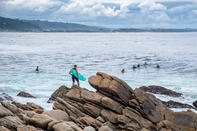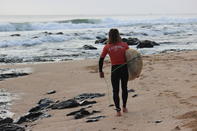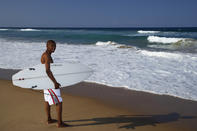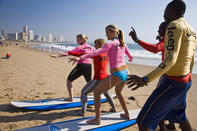South Africa is one of the top surfing destinations in the world and, consequently, there is a well-developed infrastructure for surfers.

Waves range from cute little beach breaks that 6-year-olds could learn on, to gnarly bone-crunching monsters that can compare with anything in the world.
And, best of all, there is a whole lot in between, including some fantastic little bays where the backline just rolls in and the sea looks like corduroy to the horizon.
Hang Ten History

With more than two thirds of our blue planet covered in H2O, it is no surprise that surfing has been intrinsic to the human spirit since as long ago as the twelfth century.
The first mention of this in recent history was when James Cook sailed into the beautiful bays of Hawaii in 1778. He was met amongst others by an islander paddling out to his ship on a surfboard, while lava carvings found on the island depict surfing scenes dating back at least nine hundred years.
During the early 1900s, Duke Paoa Kahanamoku, a legendary Hawaiian athlete and Olympic swimming champion, popularised the culture of surfing in the Americas. He was the first one to paddle out and tame California’s waves on his trademark redwood board, and soon built up a cult following in and around Santa Cruz.
Since then, improvements in board design and development have seen a succession of surf gods do just about everything but walk on water. The sport clicked into overdrive since the heady heyday of the surfing 60s, eventually culminating in a Zen blend of sport and lifestyle that serves as a religion to the globe’s bleach boy brigade.
The Perfect Board

Getting into surfing can be tricky - you need a few lessons before you start, and of course, the perfect board. If you are looking to buy a second-hand board (much more budget-friendly) here are some guidelines:
General Condition: if the foam is discoloured or the fibreglass is bubbling, it may mean major water damage and potential delamination. You will need time to fix this up.
Dings and cracks: It’s a used board, so what did you expect? Surface dings are generally no problem as you can fix these, but a cracked board is a no-no.
Waxed Decks: if the board you want to buy is dirty, it means you cannot see potential damage. Clean it and then check before you part with your hard-earned cash
Fins: This is where the board will take a pounding, so make sure the casings are solid and there are no cracks around the base of the fins.
Repairs: Not a problem, except if there is major discolouration of the foam below. This could mean extensive water damage, so be careful.
In addition to your board, you will need to invest in a wetsuit, especially if you’re planning to surf in the icy Atlantic. Then there’s also a board bag, a leg leash, fibreglass repair kit, wax and a scraper to add to your shopping list. These days, it is not uncommon to see surfers out there wearing shark shields or other electronic deterrents.
Ask For Help

So surfing is basically just standing upright on a board and riding a wave, right? Well, your learning curve will kick in before you dip a toe in the ocean, so never be too proud to ask for help.
Start off by getting one of the local old hands to show you how to recognise surf conditions from the safety of the beach, and learn to judge your local breaks before you endanger your life behind the surf line.
A gently sloping beach where it is shallow enough to stand in the break is perfect for your first lesson. Otherwise, you could practice your boarding technique in the broken waves just off the beach, allowing you to hone your skills before you get in over your head, so to speak.
And once you get to stand up on your board the first time, you’ll be amazed how your knowledge and confidence will grow with regular practice.